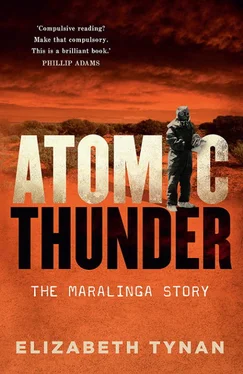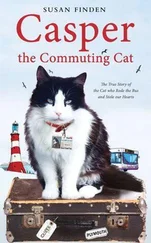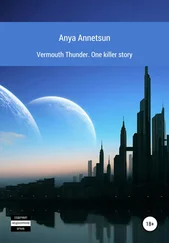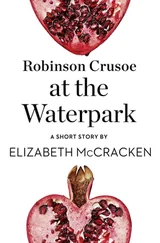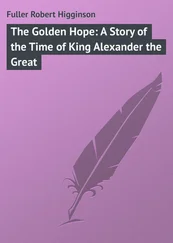The trip proved quite an adventure. MacDougall encountered some unexpected setbacks, due mainly to a lack of co-operation.
Whilst I have known most of these people for a long time, I have not had an opportunity to discuss with them their secret life, their relationships, their spiritual home country nor their water supplies or camping and hunting areas. These people are reluctant to discuss such important aspects of their tribal life with just anybody and it was not until they fully realised that I knew most of their secret life anyway and that I was not to be put off with any cock and bull story or half truths, that I was able to obtain the information that I required. I am afraid that I was led upon arrival upon several wild goose chases at the beginning.
In September 1953, a few weeks before the first Totem test at Emu Field, MacDougall conducted a patrol of the area. ‘The particular object of the patrol was to see where the 172 Jangkuntjara [ sic ] Tribe people were situated after the annual [dingo] pup [hunting] season exodus, and if necessary move them out of the prohibited areas.’ His first contact was at Wallatinna. From there he travelled on a long and complicated path to Roxby Downs, Parakylia, Mt Eba, Coober Pedy, Mabel Creek, Mt Willoughby, Wintinna and Welbourne Hill. MacDougall was well acquainted with the rhythms of the Indigenous seasons and knew more or less where he could find tribal people at various times of the year. He recorded that ‘on Sunday 27 Sep I reported to the [Woomera] Site per radio that all aborigines were accounted for and that I could return to Woomera via Kingoonya’.
In December 1953, MacDougall was on the road again, looking for older tribesmen previously based at Ooldea Soak to confer with. He believed that the increased activity by Europeans around Emu Field and Maralinga would be attracting them to the area. ‘I believe that a party with camels have been to Tietkens Well Area in the last few days obviously attracted by signs of whiteman activity.’ He constantly fretted, with good reason, that the more the white men made themselves apparent, the more the lives of the Indigenous people would be derailed.
MacDougall suggested a new trip in January 1954, to get a better understanding of what the Indigenous people were doing and how to deal with it:
The first move is to discover just what is likely to attract them. Ceremonial grounds, hunting conditions, water supplies etc. from their point of view. Secondly, everyday life conditions in their new area, also availability of new suitable ceremonial areas and to encourage the establishment of such areas.
MacDougall began this patrol on 13 January at Ooldea. The next day he encountered 300 Aborigines at Monburu tank, where ‘Pastor Strelen was in charge’. He selected one of them, a young man named Sonny Williams, to accompany him on the rest of the trek, which took in three sacred sites. MacDougall’s aim was to ensure that any sacred objects were removed from the sites, thus removing an attraction for the Aboriginal people to visit. He held the mistaken belief that moving sacred objects such as ‘totem poles’ would mean the sites would lose their sacred status. He found that sacred objects had indeed been removed: ‘All significance lost’. (Possibly Indigenous people removed these when they were forced to Yalata, though MacDougall’s notes were unclear about this.) Many years later, the Royal Commission examined this point and found that:
MacDougall’s basic assumption was incorrect: removing sacred objects did not change Ooldea’s status as a birth, death and dreaming site. Nor could this overcome the problem (for MacDougall) of people wanting to use Ooldea as a stepping-off point for sites to the north and west, or of people wanting to visit Ooldea from the north.
However, in 1954, MacDougall held that view that young people would not assign the same significance to the sites as the old people had, and that over a relatively short time the meaning of these sites, lost to weapons testing, would be lost to future generations too.
Secret life significance has ended mainly due to the lack of interest shown by the young people and the opposition to it by Missionaries. Owing to the fact that there are many of their relatives buried at Ooldea and that it is the actual birth place of many of them, there is a strong sentimental attachment. This will naturally die out in time.
Establishing Maralinga meant eliminating the Aboriginal reserve at Ooldea. MacDougall was told that this had been achieved bureaucratically in a letter from the secretary of the South Australian Aborigines Department on 14 January 1955. It said bluntly:
Please note that the whole of the Reserve for aborigines, being Section 263… has been abolished. The area surrounding the Ooldea Soak is therefore not now an aboriginal reserve. It would be appreciated if you would remove any aborigines from this area when journeying through the district.
With the stroke of a pen, the lives of thousands were changed forever. MacDougall concluded that Ooldea was of no further use to the Indigenous inhabitants because their totems had been removed: ‘No hardship would result from the withdrawal of the 900 square mile reserve provided some water supply is available at the Railway Siding’. There would be no impediment to nuclear testing from the traditional owners.
Many life-changing decisions were being made at this time. In July 1955 the AWRE decided, and the newly constituted AWTSC agreed, that they would build a meteorological station on 20 hectares in the Rawlinson Range to the northwest of the test site, just over the border into Western Australia. The station, 1500 kilometres from Maralinga, was to be called Giles, after an early explorer, and would assist in forecasting weather conditions before, during and after the Maralinga tests. In particular, the Giles station had to track the movements of air way up in the stratosphere, the currents that would affect where the atomic cloud ended up. Len Beadell and his team were brought in to grade a track from Mulga Park to Giles.
MacDougall had not yet been appointed a protector in Western Australia, so he had no jurisdiction there, but he was concerned about the effect of white people in a place frequented by Western Desert people who had had little contact with the West. When MacDougall threatened to make his concerns public via the Adelaide media, he was swiftly and brutally pulled into line. As Alan Butement made clear, the affairs of ‘natives’ were not to be placed ahead of the British Commonwealth. MacDougall was silenced and was only grudgingly allowed to participate in a September 1955 patrol to the Rawlinson Ranges with the Weapons Research Establishment’s senior range reconnaissance officer at Woomera, TR Nossiter, in preparation for the construction of the Giles station. By then, though, the decision to build Giles had already been taken. Nothing MacDougall said could stop it.
Butement also complained in June 1956 that MacDougall was providing food to Indigenous people who had congregated at Giles, ‘which action is hardly likely to ensure their early departure’. As the first major trials at Maralinga were only months away, this was a significant irritant. For Butement the presence of Aboriginal people was not the only problem: ‘I believe that the natives are from time to time putting hazards on the jeep tracks in the form of spikes which at night time might cause a serious accident’.
The weather station at Giles was disastrous for the Aboriginal people, according to MacDougall’s colleague Robert Macaulay, who was appointed as a second native patrol officer in 1956. He wrote in 1960:
Giles Weather Station has had a marked effect on the Rawlinson Natives, increasing the number of wants they are unable to satisfy. Unless employment is made available soon, it could be said that the Weapons Research Establishment has not accepted the responsibility incurred in establishing a weather station in the Reserves.
Читать дальше
